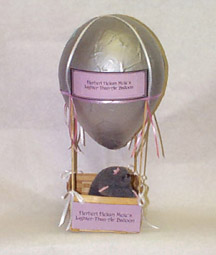Helium By Jessica Magers-Rankin |
|
| HEAVENLY HELIUM DEFINITION: Helium is an inert, colorless, odorless, gaseous element. It is in group 18 of the periodic table and is a noble gas. Helium’s atomic number is 2 and it’s symbol is He. A mole of helium (a mole describes a number of particles and a quantity of mass) is 6.02 x 10 atoms and 4.003 grams.
DISCOVERY: Pierre Janssen, a French astronomer, discovered helium in 1868. Shortly thereafter it was identified by Sir Edward Frankland, a British Chemist, and Sir Joseph Norman Lockyer, a British astronomer, as an element. In 1895, Sir William Ramsay, a British chemist, discovered helium in cleveite, an uranium-bearing mineral. In 1907, Sir Ernest Rutherford, a British physicist, deduced that alpha particles are the nuclei of the helium atoms.
PROPERTIES AND OCCURRENCE: Helium is the lightest of all gases except hydrogen. Helium solidifies at -272.2 C (-457.9 F) at pressures above 25 atmospheres; helium boils at -268.9 C (-452.0 F) and has a density of 0.1664 grams/liter at 20 C (68 F). It is chemically inert, like the other noble gases. Its single electorn shell is filled making possible reactions with other elements extremely difficult and any resulting compounds very unstable. Helium is the most difficult gas to liquefy and is impossible to solidify at normal atmospheric pressures. Thus, liquid helium is extremely useful as a refrigerant and for experimental work in producing and measuring temperatures close to absolute zero. By the rapid removal of the vapor above liquid helium, it can be cooled to almost absolute zero at normal pressure. Helium is the second most abundant element in the universe, after hydrogen.
USES: Helium is preferred to hydrogen as the lifting gas in lighter-than-air balloons because it is noncombustible. Balloons are lighter-than-air craft made of varnished silk, rubber, or other non-porous material that contain either hot air or a gas that is lighter than air. Helium has only 92 percent of the lifting power of hydrogen and is twice as heavy. Historically, helium was used quite a bit in sport balloons and in balloons during World War I. Helium is also used to pressurize and stiffen the structure of rockets before takeoff and to pressurize the tanks of liquid hydrogen, or other fuel, to force fuel into the rocket engines. A possible use of helium is as a heat-transfer medium in nuclear reactors because it would remain chemically inert and nonradioactive under the conditions that exist within the nuclear reactors. Helium is used in welding for light metals that might otherwise oxidize; it protects heated parts from attack by air. Helium is used in place of nitrogen as part of the synthetic atmosphere breathed by deep-sea divers, caisson workers, and others, because it reduces susceptibility to the bends. This synthetic atmosphere is also used in medicine for those with breathing difficulties because helium moves more easily than nitrogen through constricted respiratory passages. In addition, beams of ionized helium are proving useful in treating eye tumors and shrinking blood-vessel malformations in the brain. In small quantities, helium is transported as a gas compressed in heavy steel cylinders. Larger amounts can be shipped as a liquid in insulated containers, thus saving shipping costs. |
